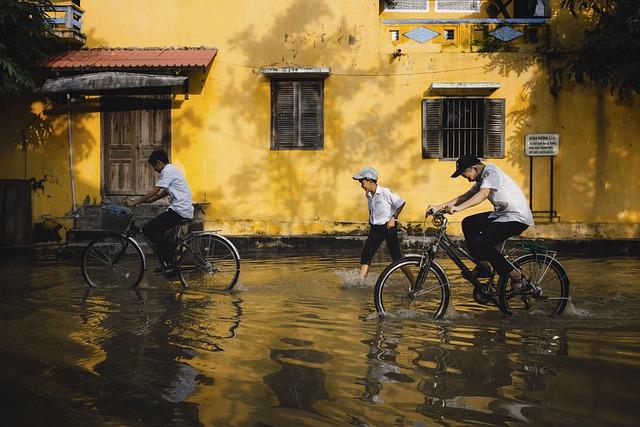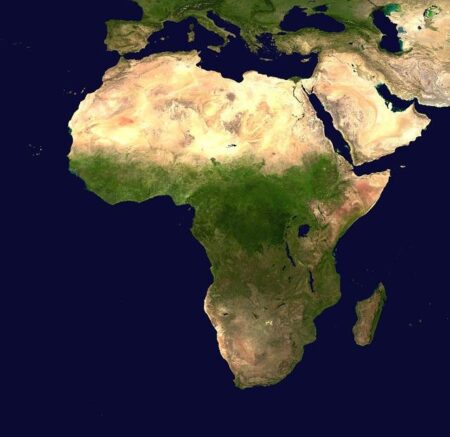Introduction
Between 2020 and 2023, the Horn of Africa has faced a tumultuous landscape marked by extreme weather events, fluctuating between devastating floods and crippling drought. These climate phenomena have not only wreaked havoc on local communities but have also posed important challenges to humanitarian efforts and disaster response initiatives. In response to these escalating crises, the United Nations Office for Disaster Risk Reduction (UNDRR) has undertaken a comprehensive forensic analysis to identify the underlying causes, impacts, and lessons learned from these disasters. This article delves into the findings of the UNDRR’s investigation, exploring how climate change, socio-economic factors, and infrastructural vulnerabilities have compounded the region’s plight, ultimately shaping a narrative of resilience amidst adversity. Through this examination, we aim to shed light on the urgent need for sustainable solutions and robust disaster preparedness frameworks to safeguard the lives and livelihoods of millions in the horn of africa.
Impact of Climate Change on Horn of Africa Floods and Drought Patterns

The Horn of Africa has been besieged by increasingly erratic weather patterns driven by climate change, causing a dual crisis of floods and droughts. These extreme events have become more frequent and severe, straining the resilience of local communities and ecosystems. Some of the key factors contributing to these shifts include:
- Rising Temperatures: Increased global temperatures have intensified evaporation rates, leading to unpredictable rainfall distribution.
- Altered Weather Patterns: Climate change has disrupted traditional weather cycles, resulting in prolonged dry spells followed by intense rainfall.
- Soil Degradation: overexploitation and poor land management have rendered soils less capable of absorbing heavy rains, increasing runoff and flooding risks.
Consequently, millions are affected, leading to humanitarian emergencies that require urgent response strategies. Analysis of recent flooding and drought data indicates that these events have profound socio-economic impacts, including:
| Impact zone | Floods (2020-2023) | Droughts (2020-2023) |
|---|---|---|
| Agriculture | Crop loss and livestock death | Reduced yields and food shortages |
| Health | Waterborne diseases increase | Malnutrition and health crises |
| Economy | Infrastructure damage and recovery costs | Decreased incomes and poverty elevation |
Assessment of Humanitarian Response Efforts and Challenges in the Region

The humanitarian response efforts in the Horn of Africa from 2020 to 2023 have faced a myriad of challenges due to the dual impacts of severe floods and prolonged drought. organizations such as the United nations and various NGOs have mobilized resources to address the immediate needs of affected populations, yet the scale of the crises has frequently enough outpaced these efforts. Key obstacles include:
- Logistical difficulties: Inaccessibility of remote affected areas complicates the distribution of aid.
- Funding shortages: Insufficient financial resources hinder effective program implementation.
- Coordination issues: Fragmentation among different aid organizations creates gaps and overlaps in service delivery.
- Security concerns: Ongoing conflicts in certain regions restrict the safe movement of humanitarian workers.
Despite these challenges, some notable achievements have emerged from the efforts. Flexible frameworks for crisis management were established, allowing for rapid response to shifting conditions. The integration of local communities into planning and implementation has led to more sustainable outcomes. Critical factors contributing to the successes include:
| Success Factor | description |
|---|---|
| Community Engagement | Involvement of local leaders to enhance trust and facilitate aid distribution. |
| Innovative Solutions | Use of technology for real-time data collection and needs assessment. |
| Collaborative Approaches | Partnerships among NGOs, governments, and international bodies to share resources. |
Economic Consequences of Water Scarcity and Flooding in Affected Areas

Water scarcity and flooding represent dual challenges for the economies of the Horn of Africa, notably in the aftermath of the climate events recorded between 2020 and 2023. These environmental crises compromise agricultural productivity, which forms the backbone of local livelihoods and food security. The measurable economic effects include:
- Reduced crop yields, leading to higher food prices and increased import dependency.
- Disruption in local supply chains, exacerbating job losses in both rural and urban settings.
- Loss of livestock, diminishing income for pastoral communities and reducing overall community resilience.
Moreover, the financial repercussions extend to infrastructural damages, where flooding frequently enough obliterates critical roads and bridges, hindering trade and transportation. As local governments strive to address these challenges, their budgets are strained, resulting in significantly reduced public investment in sustainable growth initiatives, which could mitigate future risks. Key economic implications include:
| Economic Impact | Short-term Effects | Long-term Consequences |
|---|---|---|
| Income Decrease | Immediate loss of agricultural income | Persistent poverty cycles |
| Job Losses | Unemployment spikes in affected regions | Skill erosion and migration to urban areas |
| Increased Food Insecurity | Surge in malnutrition rates | Long-term health issues and economic instability |
Infrastructure Resilience: lessons Learned from Recent Disasters

The recent floods and droughts that have ravaged the Horn of Africa from 2020 to 2023 serve as a stark reminder of the vulnerabilities inherent in regional infrastructures. With shifts in climate patterns resulting in both excessive rainfall and prolonged dry spells, key infrastructures such as roads, bridges, and water supply systems have faced unprecedented stress.A forensic analysis reveals that a combination of factors has contributed to the challenges of maintaining resilience, including inadequate planning, poor maintenance, and limited financial resources.Areas hit hardest often shared common characteristics, such as:
- Underinvestment in flood defense mechanisms
- Inaccessible emergency response routes
- Insufficient education on disaster preparedness among local populations
Lessons from the devastation underline the necessity of proactive measures to strengthen infrastructure resilience.Stakeholders must prioritize integrated disaster risk management strategies that combine the expertise of urban planners, environmental scientists, and community leaders.This approach should be complemented by enhanced monitoring and early warning systems to mitigate risks. A comparative view of response effectiveness in various regions can further shed light on what works and what does not. The following table illustrates different approaches taken across communities impacted by the climate crisis:
| Community | response Strategy | Outcome |
|---|---|---|
| Community A | Reinforced irrigation systems | Reduced crop loss by 30% |
| Community B | Constructed elevated pathways | Improved access during floods |
| Community C | Community education programs | Increased disaster preparedness |
Pathways to Sustainable Water management and Disaster Risk Reduction

Effective water management is crucial for mitigating the impacts of climate-related disasters in the Horn of Africa, where floods and droughts have become increasingly frequent and severe from 2020 to 2023.To address these challenges, stakeholders must employ an integrated approach that emphasizes both conservation and sustainable use of water resources. This can be facilitated through:
- Rainwater Harvesting: Implementing systems that collect and store rainwater can significantly increase water availability during dry spells.
- Agroecological Practices: Promoting crop varieties that require less water and adopting soil management techniques that improve moisture retention can enhance agricultural resilience.
- Community Engagement: Involving local populations in water management decisions ensures that strategies are culturally appropriate and more likely to succeed.
Moreover, disaster risk reduction strategies must align with sustainable water management practices to create a holistic framework that prioritizes community needs and ecological balance. Early warning systems and climate resilience planning play pivotal roles in this paradigm, helping to prepare for unforeseen events.Some actionable measures include:
| Strategy | Description |
|---|---|
| Integrative Water Policies | Cross-institutional collaboration to create comprehensive water management policies. |
| capacity Building | Training programs to enhance local expertise in water resource management. |
| Technological Innovation | Utilizing technology for better water monitoring and management systems. |
Policy Recommendations for Enhanced Regional Cooperation and Preparedness

To effectively address the challenges posed by the recurring floods and droughts in the Horn of Africa, a multifaceted approach to regional cooperation and preparedness is essential.Stakeholders are urged to integrate a framework that encompasses:
- Data Sharing: Establishing a regional database for climate-related data to ensure timely sharing of information among countries.
- Joint Training Programs: Implementing training initiatives for disaster response teams across borders, fostering a culture of collaboration and mutual assistance.
- Resource Mobilization: Creating a pooled fund to ensure rapid mobilization of resources during emergencies, allowing for a coordinated response to disasters.
- Community Engagement: Strengthening local community resilience by involving them in planning and execution of disaster management strategies.
Moreover, collaboration with international organizations should be strengthened to enhance the capacity for disaster risk reduction. It is critical to develop:
| Strategy | Objective |
|---|---|
| Regional Early Warning Systems | To provide accurate forecasts for timely response. |
| Joint Simulation Exercises | To test and improve emergency response protocols. |
| Policy Harmonization | to align national policies with regional goals. |
| Cross-Border Cooperation Agreements | To facilitate smooth aid delivery across regions. |
Concluding Remarks
the forensic analysis of the floods and drought in the horn of Africa from 2020 to 2023 underscores the urgent need for comprehensive disaster risk reduction strategies in the region. As evidenced by the troubling interplay of climatic extremes,humanitarian crises,and socio-economic vulnerabilities,the findings from the United Nations office for Disaster Risk reduction highlight the imperative for a coordinated response that not only addresses immediate relief but also fosters long-term resilience.
Policymakers, humanitarian organizations, and local communities must collaborate effectively to implement sustainable practices that mitigate risk and enhance adaptation to climate variability. The path forward demands an integrated approach that incorporates scientific insights, community engagement, and robust infrastructure development to withstand the impacts of future disasters. As the Horn of Africa grapples with the twin challenges of floods and drought, it serves as a clarion call for collective action in the face of a changing climate, reminding us that preparedness and resilience are not just options, but essential components of safeguarding lives and livelihoods in one of the world’s moast vulnerable regions.







